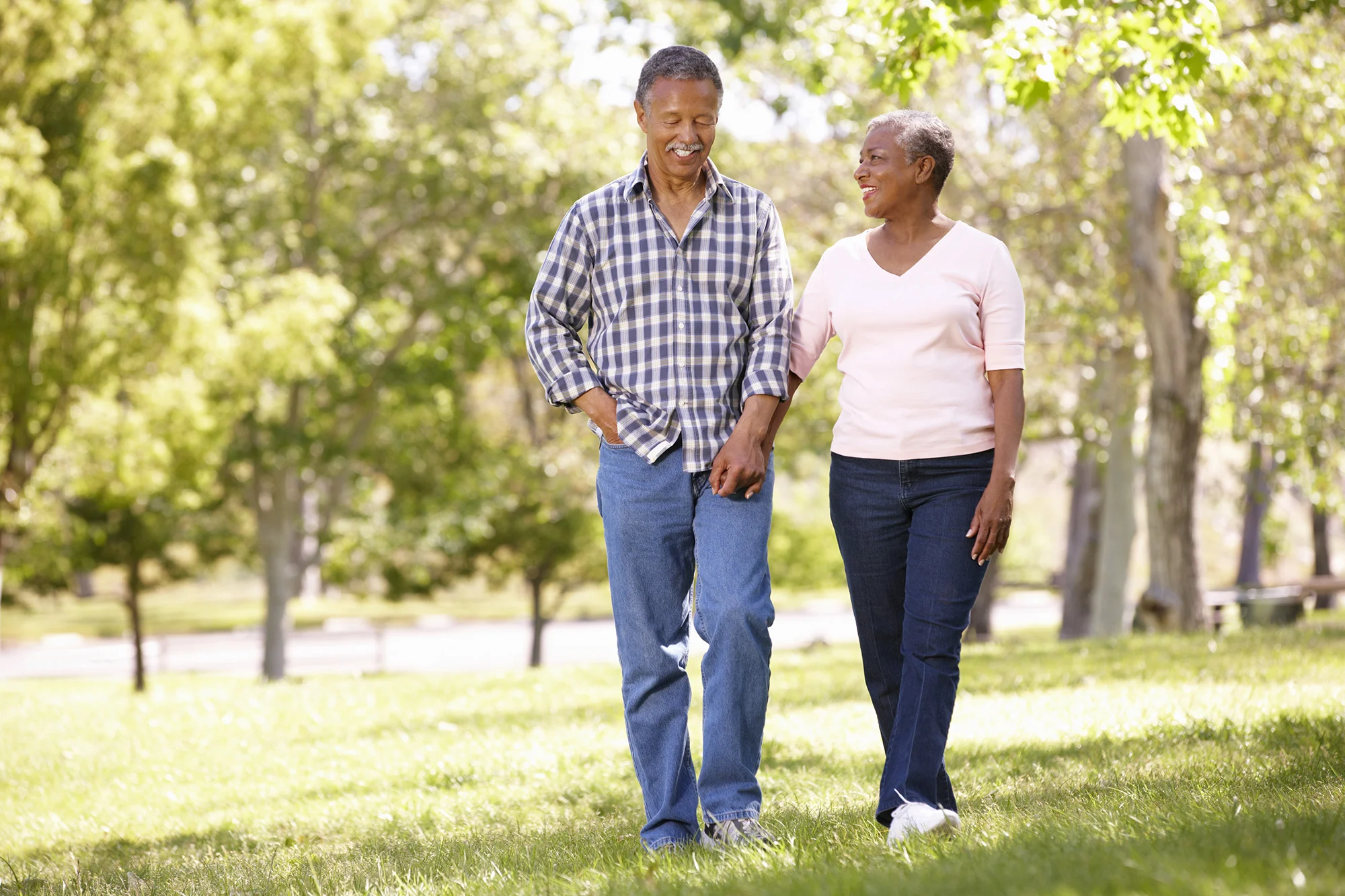At a glance These Joints Were Made for Walking |
What makes walking such an effective exercise?
Here’s the short answer: it is straightforward, yet rewarding; it is basic, but fun; it is easy to master, and still beneficial to multiple areas of health.
Simply put, walking is an easy, convenient, and effective workout that is good for your joints, supports your heart, helps strengthen your muscles and bones, and more.
A survey from the U.S. Bureau of Labor Statistics found that walking is the most popular exercise activity among Americans aged 15 years and older who engaged in exercise on a daily basis. Of the various sports and exercise activities measured, 30% of this segment of the population favored walking, followed by weightlifting, the use of cardiovascular equipment, swimming/surfing/water skiing, and, lastly, running. And while that report was done over a decade ago, walking has only gained in popularity since then!
The same survey found that walking was almost equally enjoyed by both men and women (57% women, 43% men), unlike other activities such as golfing (82% men, 18% women), soccer (80% men, 20% women), and even cycling (66% men, 34% women).
Although walking was found to be the most popular exercise activity among Americans aged 15 years and older, only 7% were aged 15-24 years. The overwhelming majority of walkers belonged to the following subsegments: 25-54 years old (45%) and 55 years and older (48%).
And with that, here are 5 reasons why you should grab your water bottle, lace up your sneakers, and start walking!
1. It Supports Your Joints
According to the Arthritis Foundation, walking is easy on the joints. Most of our joint cartilage does not receive a direct supply of blood. Instead, our joint cartilage gets its nutrition from joint fluid that circulates as we move. When you walk, it provides movement and compression to your cartilage, which provides it with oxygen and nutrients.
In short: a low-impact exercise such as walking increases blood flow to your cartilage. Any movement you perform while walking helps lubricate your joints, increase range of motion, and even decrease pain and stiffness.
Walking may also help decrease the risk of physical disability in older adults, according to a recent study published in the American Journal of Preventative Medicine.
- Researchers at Northwestern University reviewed 4 years of material gathered from over 1,500 older adults who experienced lower extremity joint symptoms.
- The results showed that after just one hour a week (total) of brisk walking (which is less than 10 minutes a day), older adults were able to maintain their ability to carry out daily task such as getting dressed and safely crossing a street.
- According to the researchers at Northwestern, this minimum threshold has value as a goal to motivate elderly adults to take actions towards the health benefits of remaining physical active.
2. It Is A Hearty Workout For Your Cardiovascular System
There are plenty of reasons why the National Heart Foundation of Australia calls walking the “wonder drug.” For example, walking for an average of 30 minutes or more a day can lower the risk of heart disease, manage weight, help control blood pressure and blood cholesterol, and so much more.
If you find yourself struggling to find time for a 30-minute walk, the Heart Foundation suggests breaking the half-hour workout into three 10-minute sessions.
A 2010 review titled “Walking – the first steps in cardiovascular disease prevention” analyzed recent evidence of the health benefits of walking.
- Large observational studies within the review consistently demonstrated beneficial associations between walking and cardiovascular disease. These observational studies suggest that walking for a long duration may “confer incremental protection against cardiovascular disease (CVD).”
- Intervention studies support the health benefits of walking, as the workout appears to have positive effects on CVD-related benefits in young, middle-aged, and elderly men and women.
- The review concluded its analysis with the following: “Walking has the potential to play a key role in the primary and secondary prevention of cardiovascular disease. Clinicians can prescribe walking to assist patients meet physical activity recommendations and help identify supports available to the patient.”
A separate study was conducted to assess the effects of walking on sedentary adults with varying levels of systolic blood pressure (SBP).
- 529 adults with SBP above 130 mmHg (millimeters of mercury) were enrolled in the study. For reference, the American Heart Association considers a systolic blood pressure less than 120 to be normal. Factors such as blood pressure, body weight, body mass index, waist circumference, and walking speed were measured at both the start and conclusion of the study. Exercise physiologists were present to supervise the walking session.
- After 6 months of supervised walking, SBP was “significantly reduced” in all test groups. The greatest reduction occurred in subjects with a baseline SBP exceeding 160 mmHG, whereas subjects with baseline of 120-129 mmHG experienced the smallest difference in SBP
- Other factors such as diastolic blood pressure, body weight, body mass index, and waist circumference were significantly reduced as well.
3. It Helps You Sleep
The Sleep Foundation notes that regular exercise can help most people achieve better quality sleep. But when it comes to sleep trouble, only moderate-intensity aerobic exercise, such as walking, has shown to relieve common sleep disorders including insomnia. In fact, just one 30-minute exercise session can reduce sleep latency (how long it takes to fall asleep), and even help you sleep longer. However, your body benefits more when you engage in a regular exercise program.
- A 2011 study evaluated the effect of long-term moderate exercise on sleep, as well as quality-of-life and mood of individuals with chronic primary insomnia.
- 19 subjects with an average age of 45 years underwent a 6-month training protocol that randomly assigned subjects to morning and late-afternoon exercise groups.
- The results showed a significant decrease in sleep onset latency and sleep duration after exercise. Significant increases in sleep efficacy, sleep quality, and feeling rested in the morning also occurred.
- Some quality-of-life measures were improved significantly. Plus, subjects experienced a significant decrease in Profile of Mood state measures such as tension-anxiety and total mood disturbance.
4. It Improves Your Balance
According to the Medical School at Harvard University, a person’s sense of balance typically worsens with age. Certain medical conditions, vision problems, and lack of flexibility are some of the factors that attribute to poor balance, which often leads to falls.
About 36 million older adults fall each year, according to the CDC. One out of every five falls causes injury, including broken bones or even a head injury. And though falling may seem like a normal part of aging, it is not. Here’s what you can do to improve your balance:
- Physical activity such as walking, strength training, and other workouts can help improve balance and prevent falls in adults, especially the elderly.
- Harvard also notes that walking helps build lower-body strength, which is an important component of good balance.
- Therefore, if you aren’t a regular participant in exercise, it may be beneficial to set up a good walking plan. It should be designed to safely enhance physical activity in adults who are sedentary, and even those who already active.
- Remember: prioritize the minutes, not the miles. If you do not already have one, start with a walking plan that feels most comfortable to you. It is important to start with something comfortable, then build from there.
- As always, talk with your doctor about fall risks, and other measures of fall prevention.
5. It Strengthens Your Muscles and Bones
According to Michael A. Schwartz, MD, a New York-based orthopedic surgeon, walking can stop the loss of bone mass for those with osteoporosis.
As for your muscles, the Arthritis Foundation states that walking tones your leg and abdominal muscles, as well as your arm muscles if you pump them while walking. This activity shifts the pressure and weight from your joints to your muscles, and even increases your range of motion.
What’s more, a 2014 assessment published in the American Journal of Public Heath determined that walking is a relatively safe and easy activity for hip fracture prevention.
- This body of research revealed a clear association between physical activity and hip fractures in men.
- The following methods were used: reported time spent walking, as well as other recreational activities such as jogging and running were measured every 2 years in over 35,000 men aged 50 years and older from 1986 to 2010.
- The 24-year period found that more walking time, with little other exercise, lowered risk of fracture by 43%.
- Further, regular physical activity may work in several different ways to prevent hip fractures. For example, site specific weight-bearing exercise and resistance training can reduce hip fracture risk by increasing mechanical load on bone, which promotes an increase in bone density.
The key takeaway is that regular, weight-bearing aerobic activities such as walking benefit your muscles and bones.
References
https://www.ajpmonline.org/article/S0749-3797(19)30045-5/fulltext
https://www.bls.gov/spotlight/2008/sports/
https://creakyjoints.org/diet-exercise/walking-with-arthritis/
https://www.health.harvard.edu/staying-healthy/improve-your-balance-by-walking
https://www.heart.org/en/health-topics/high-blood-pressure/understanding-blood-pressure-readings
https://www.mayoclinic.org/walking-for-muscle-and-bone-health/art-20457588
https://www.ncbi.nlm.nih.gov/pmc/articles/PMC3098122/
https://www.ncbi.nlm.nih.gov/pmc/articles/PMC3983666/
https://www.ncbi.nlm.nih.gov/pmc/articles/PMC6119598/
https://pubmed.ncbi.nlm.nih.gov/22019457/
https://www.sleepfoundation.org/insomnia/exercise-and-insomnia
https://walking.heartfoundation.org.au/benefits-of-walking
https://www.wphphysicianassociates.org/doctors/dr-michael-a-schwartz-md/









